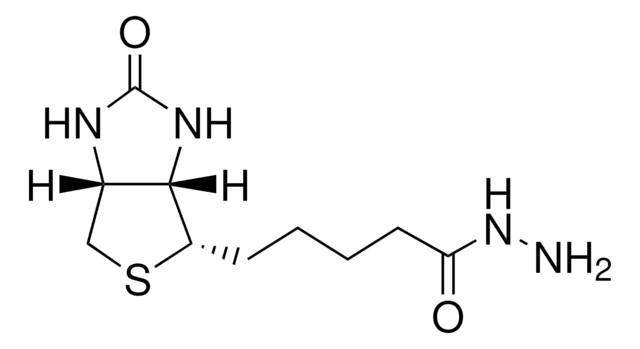B2059
Biotin Polyethyleneoxide Iodoacetamide
Synonym(s):
Biotin PEO Iodoacetamide
About This Item
Recommended Products
description
Sulfhydryl specific, water soluble biotinylation reagent
Quality Level
form
powder
solubility
H2O: 10 mg/mL
storage temp.
2-8°C
SMILES string
ICC(=O)NCCOCCOCCNC(=O)CCCCC1SCC2NC(=O)NC12
InChI
1S/C18H31IN4O5S/c19-11-16(25)21-6-8-28-10-9-27-7-5-20-15(24)4-2-1-3-14-17-13(12-29-14)22-18(26)23-17/h13-14,17H,1-12H2,(H,20,24)(H,21,25)(H2,22,23,26)
InChI key
LWGLKVINXNMNJX-UHFFFAOYSA-N
Related Categories
General description
Application
- Incorporates a 12 atom hydrophilic spacer.
- Typically coupled to sulfhydryl groups at pH 7.5 - 8.5
- Especially useful for cysteine labeling in many proteomics type applications such as peptide mapping and mass spectrometry.
Biochem/physiol Actions
Signal Word
Warning
Hazard Statements
Precautionary Statements
Hazard Classifications
Eye Irrit. 2 - Skin Irrit. 2 - STOT SE 3
Target Organs
Respiratory system
Storage Class Code
11 - Combustible Solids
WGK
WGK 3
Flash Point(F)
Not applicable
Flash Point(C)
Not applicable
Personal Protective Equipment
Certificates of Analysis (COA)
Search for Certificates of Analysis (COA) by entering the products Lot/Batch Number. Lot and Batch Numbers can be found on a product’s label following the words ‘Lot’ or ‘Batch’.
Already Own This Product?
Find documentation for the products that you have recently purchased in the Document Library.
Articles
The recent emergence of a number of highly functional nanomaterials has enabled new approaches to the understanding, diagnosis, and treatment of cancer.
Our team of scientists has experience in all areas of research including Life Science, Material Science, Chemical Synthesis, Chromatography, Analytical and many others.
Contact Technical Service








